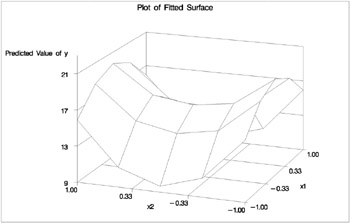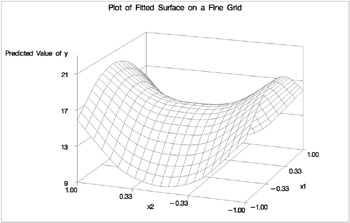Getting Started
The following example demonstrates how you can use the TPSPLINE procedure to fit a semiparametric model.
Suppose that y is a continuous variable and x1 and x2 are two explanatory variables of interest. To fit a smoothing spline model, you can use a MODEL statement similar to that used in many regression procedures in the SAS System.
proc tpspline; model y = (x1 x2); run;
The TPSPLINE procedure can fit semiparametric models; the parentheses in the preceding MODEL statement separates the smoothing variables from the regression variables. The following statements illustrates this syntax.
proc tpspline; modely = x3 (x1 x2); run;
This model assumes a linear relation with x3 and an unknown functional relation with x1 and x2 .
If you want to fit several responses using the same explanatory variables, you can save computation time by using the multiple responses feature in the MODEL statement. For example, if y1 and y2 are two response variables, the following MODEL statement can be used to fit two models. Separate analyses are then performed for each response variable.
proc tpspline; model y1 y2 = (x1 x2); run;
The following example illustrates the use of PROC TPSPLINE. The data are from Bates, Lindstrom, Wahba, and Yandell (1987).
data Measure; input x1 x2 y @@; datalines; 1.0 1.0 15.54483570 1.0 1.0 15.76312613 .5 1.0 18.67397826 .5 1.0 18.49722167 .0 1.0 19.66086310 .0 1.0 19.80231311 .5 1.0 18.59838649 .5 1.0 18.51904737 1.0 1.0 15.86842815 1.0 1.0 16.03913832 1.0 .5 10.92383867 1.0 .5 11.14066546 .5 .5 14.81392847 .5 .5 14.82830425 .0 .5 16.56449698 .0 .5 16.44307297 .5 .5 14.90792284 .5 .5 15.05653924 1.0 .5 10.91956264 1.0 .5 10.94227538 1.0 .0 9.61492010 1.0 .0 9.64648093 .5 .0 14.03133439 .5 .0 14.03122345 .0 .0 15.77400253 .0 .0 16.00412514 .5 .0 13.99627680 .5 .0 14.02826553 1.0 .0 9.55700164 1.0 .0 9.58467047 1.0 .5 11.20625177 1.0 .5 11.08651907 .5 .5 14.83723493 .5 .5 14.99369172 .0 .5 16.55494349 .0 .5 16.51294369 .5 .5 14.98448603 .5 .5 14.71816070 1.0 .5 11.14575565 1.0 .5 11.17168689 1.0 1.0 15.82595514 1.0 1.0 15.96022497 .5 1.0 18.64014953 .5 1.0 18.56095997 .0 1.0 19.54375504 .0 1.0 19.80902641 .5 1.0 18.56884576 .5 1.0 18.61010439 1.0 1.0 15.86586951 1.0 1.0 15.90136745 ;
The dataset Measure contains three variables x1 , x2 ,and y . Suppose that you want to fit a surface by using the variables x1 and x2 to model the response y . The variables x1 and x2 are spaced evenly on a [ ˆ’ 1 — 1] — [ ˆ’ 1 — 1] square, and the response y is generated by adding a random error to a function f ( x 1 ,x 2). The raw data are plotted using the G3D procedure. In order to plot those replicates, the data are jittered a little bit.
data Measure1; set Measure; run; proc sort data=Measure1; by x2 x1; run; data measure1; set measure1; by x1; if last.x1 then x1=x1+0.00001; run; proc g3d data=Measure1; scatter x2*x1=y /size=.5 zmin=9 zmax=21 zticknum=4; title "Raw Data"; run;
Figure 74.1 displays the raw data.

Figure 74.1: Plot of Data Set MEASURE
The following statements invoke the TPSPLINE procedure, using the Measure data set as input. In the MODEL statement, the x1 and x2 variables are listed as smoothing variables. The LOGNLAMBDA= option returns a list of GCV values with log 10 ( n » ) ranging from ˆ’ 4 to ˆ’ 2. The OUTPUT statement creates the data set estimate to contain the predicted values and the 95% upper and lower confidence limits.
proc tpspline data=Measure; model y=(x1 x2) /lognlambda=( 4 to 2 by 0.1); output out=estimate pred uclm lclm; run; proc print data=estimate; run;
The results of this analysis are displayed in the following figures. Figure 74.2 shows that the data set Measure contains 50 observations with 25 unique design points. The GCV values are listed along with the log 10 of n » . The value of log 10 ( n » ) that minimizes the GCV function is around ˆ’ 3 . 5.Thefinal thin-plate smoothing spline estimate is based on LOGNLAMBDA = ˆ’ 3.4762. The residual sum of squares is 0.246110, and the degrees of freedom is 24.593203. The standard deviation, defined as RSS/(Tr(I-A)), is 0.098421. The predictions and 95% confidence limits are displayed in Figure 74.3.
| |
Estimates from Proc TPSPLINE Obs x1 x2 y P_y LCLM_y UCLM_y 1 1.0 1.0 15.5448 15.6474 15.5115 15.7832 2 1.0 1.0 15.7631 15.6474 15.5115 15.7832 3 0.5 1.0 18.6740 18.5783 18.4430 18.7136 4 0.5 1.0 18.4972 18.5783 18.4430 18.7136 5 0.0 1.0 19.6609 19.7270 19.5917 19.8622 6 0.0 1.0 19.8023 19.7270 19.5917 19.8622 7 0.5 1.0 18.5984 18.5552 18.4199 18.6905 8 0.5 1.0 18.5190 18.5552 18.4199 18.6905 9 1.0 1.0 15.8684 15.9436 15.8077 16.0794 10 1.0 1.0 16.0391 15.9436 15.8077 16.0794 11 1.0 0.5 10.9238 11.0467 10.9114 11.1820 12 1.0 0.5 11.1407 11.0467 10.9114 11.1820 13 0.5 0.5 14.8139 14.8246 14.6896 14.9597 14 0.5 0.5 14.8283 14.8246 14.6896 14.9597 15 0.0 0.5 16.5645 16.5102 16.3752 16.6452 16 0.0 0.5 16.4431 16.5102 16.3752 16.6452 17 0.5 0.5 14.9079 14.9812 14.8461 15.1162 18 0.5 0.5 15.0565 14.9812 14.8461 15.1162 19 1.0 0.5 10.9196 10.9497 10.8144 11.0850 20 1.0 0.5 10.9423 10.9497 10.8144 11.0850 21 1.0 0.0 9.6149 9.6372 9.5019 9.7724 22 1.0 0.0 9.6465 9.6372 9.5019 9.7724 23 0.5 0.0 14.0313 14.0188 13.8838 14.1538 24 0.5 0.0 14.0312 14.0188 13.8838 14.1538 25 0.0 0.0 15.7740 15.8822 15.7472 16.0171 26 0.0 0.0 16.0041 15.8822 15.7472 16.0171 27 0.5 0.0 13.9963 14.0006 13.8656 14.1356 28 0.5 0.0 14.0283 14.0006 13.8656 14.1356 29 1.0 0.0 9.5570 9.5769 9.4417 9.7122 30 1.0 0.0 9.5847 9.5769 9.4417 9.7122 31 1.0 0.5 11.2063 11.1614 11.0261 11.2967 32 1.0 0.5 11.0865 11.1614 11.0261 11.2967 33 0.5 0.5 14.8372 14.9182 14.7831 15.0532 34 0.5 0.5 14.9937 14.9182 14.7831 15.0532 35 0.0 0.5 16.5549 16.5386 16.4036 16.6736 36 0.0 0.5 16.5129 16.5386 16.4036 16.6736 37 0.5 0.5 14.9845 14.8549 14.7199 14.9900 38 0.5 0.5 14.7182 14.8549 14.7199 14.9900 39 1.0 0.5 11.1458 11.1727 11.0374 11.3080 40 1.0 0.5 11.1717 11.1727 11.0374 11.3080 41 1.0 1.0 15.8260 15.8851 15.7493 16.0210 42 1.0 1.0 15.9602 15.8851 15.7493 16.0210 43 0.5 1.0 18.6401 18.5946 18.4593 18.7299 44 0.5 1.0 18.5610 18.5946 18.4593 18.7299 45 0.0 1.0 19.5438 19.6729 19.5376 19.8081 46 0.0 1.0 19.8090 19.6729 19.5376 19.8081 47 0.5 1.0 18.5688 18.5832 18.4478 18.7185 48 0.5 1.0 18.6101 18.5832 18.4478 18.7185 49 1.0 1.0 15.8659 15.8761 15.7402 16.0120 50 1.0 1.0 15.9014 15.8761 15.7402 16.0120
| |
Figure 74.3: Data Set ESTIMATE
The TPSPLINE Procedure Dependent Variable: y GCV Function log10(n*Lambda) GCV 4.000000 0.019215 3.900000 0.019183 3.800000 0.019148 3.700000 0.019113 3.600000 0.019082 3.500000 0.019064* 3.400000 0.019074 3.300000 0.019135 3.200000 0.019286 3.100000 0.019584 3.000000 0.020117 2.900000 0.021015 2.800000 0.022462 2.700000 0.024718 2.600000 0.028132 2.500000 0.033165 2.400000 0.040411 2.300000 0.050614 2.200000 0.064699 2.100000 0.083813 2.000000 0.109387 Note: * indicates minimum GCV value. Summary Statistics of Final Estimation log10(n*Lambda) 3.4762 Smoothing Penalty 2558.1432 Residual SS 0.2461 Tr(I-A) 25.4068 Model DF 24.5932 Standard Deviation 0.0984
The fitted surface is plotted with PROC G3D as follows .
proc g3d data=estimate; plot x2*x1=p_y/grid zmin=9 zmax=21 zticknum=4; title 'Plot of Fitted Surface'; run;
The resulting plot is displayed in Figure 74.4.

Figure 74.4: Plot of TPSPLINE Fit of Data Set Measure
Because the data in data set Measure are very sparse, the fitted surface is not smooth. To produce a smoother surface, the following statements generate the data set Pred in order to obtain a finer grid. The SCORE statement evaluates the fitted surface at those new design points.
data pred; do x1= 1 to 1 by 0.1; do x2= 1 to 1 by 0.1; output; end; end; run; proc tpspline data=measure; model y=(x1 x2)/lognlambda=( 4 to 2 by 0.1); score data=pred out=predy; run; proc g3d data=predy; plot x2*x1=p_y/grid zmin=9 zmax=21 zticknum=4; title 'Plot of Fitted Surface on a Fine Grid'; run;
The surface plot based on the finer grid is displayed in Figure 74.5. The plot shows that a parametric model with quadratic terms of x1 and x2 provides a reasonable fit to the data.

Figure 74.5: Plot of TPSPLINE fit